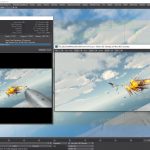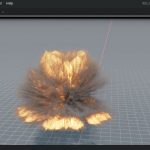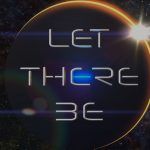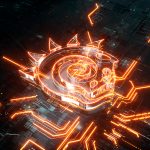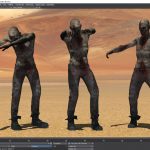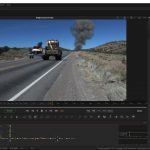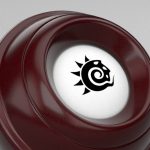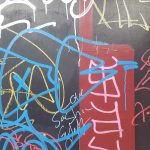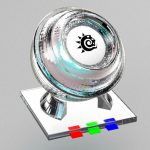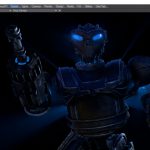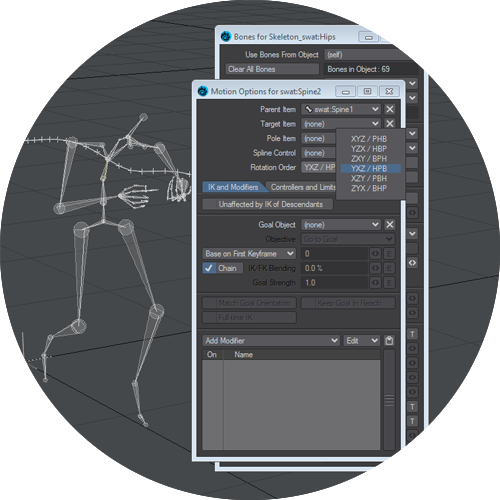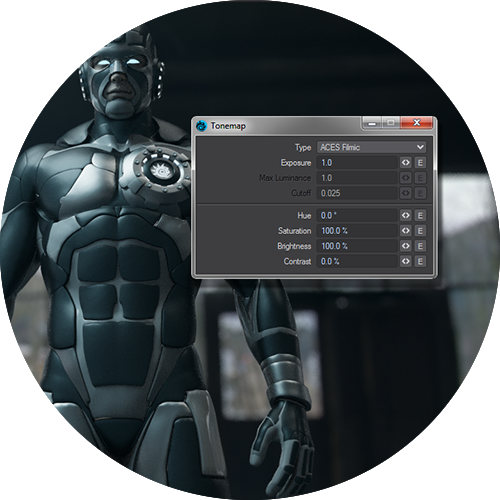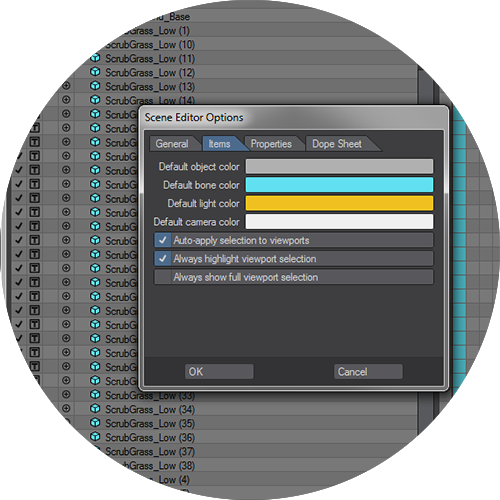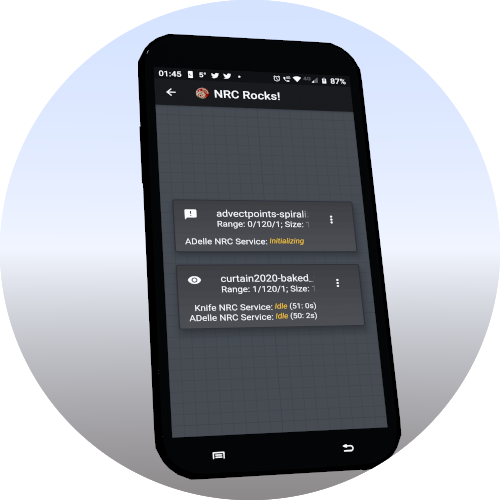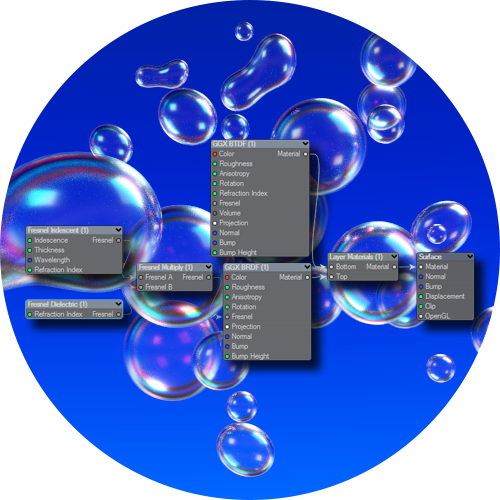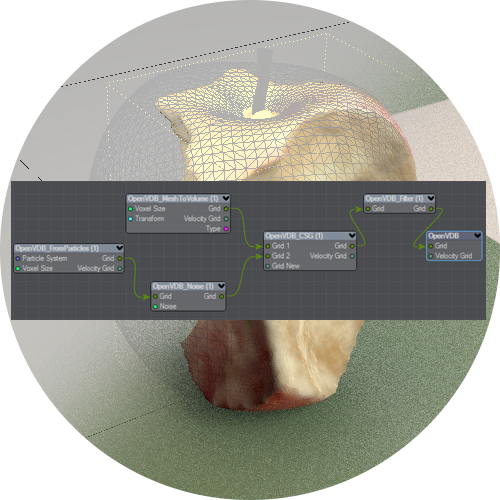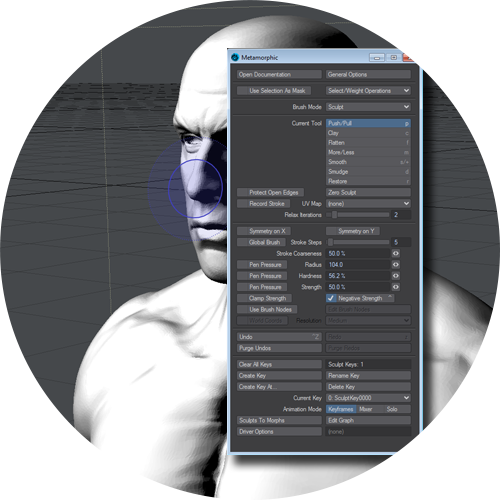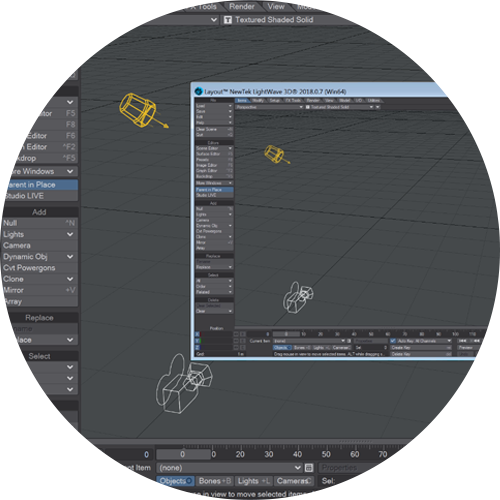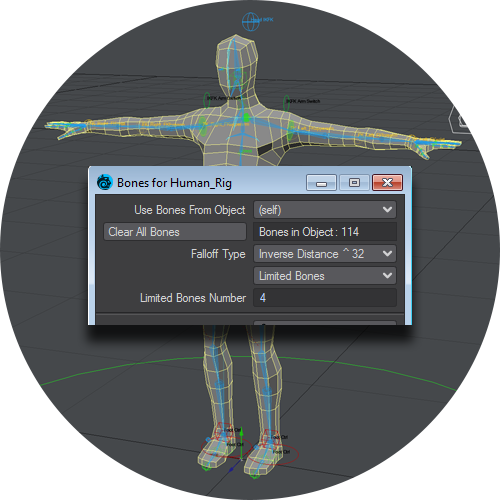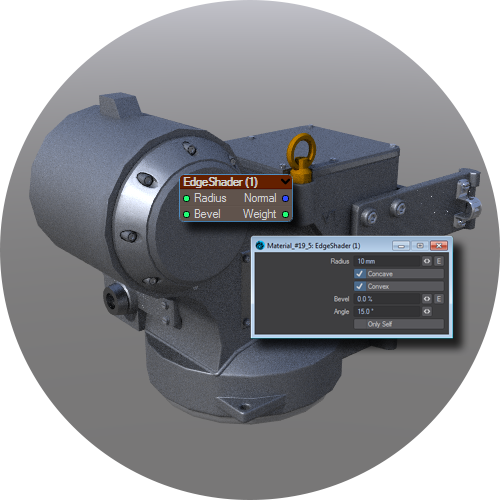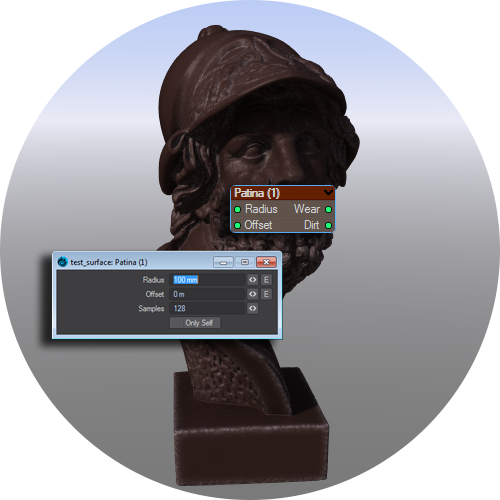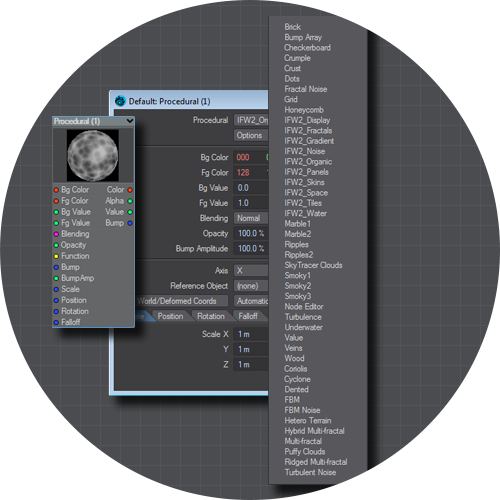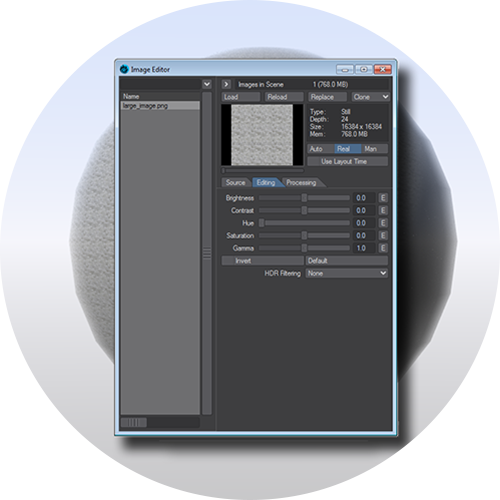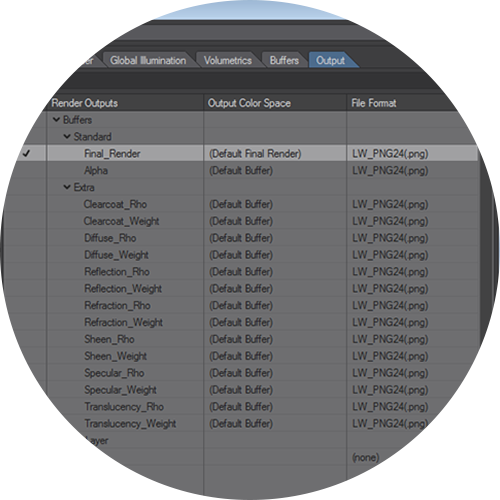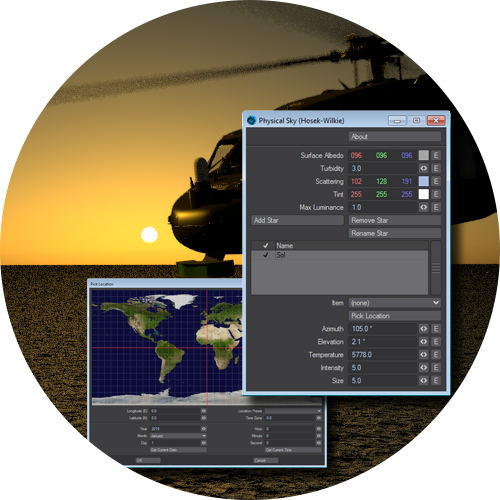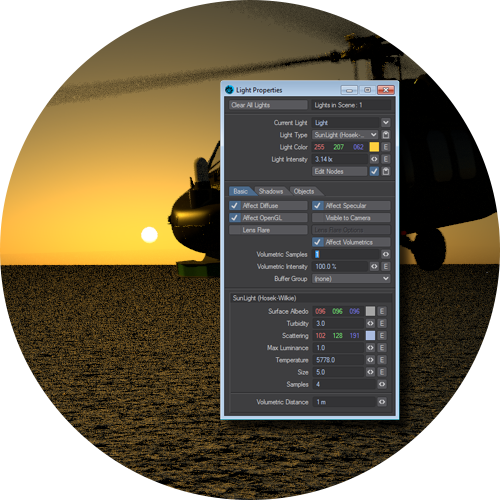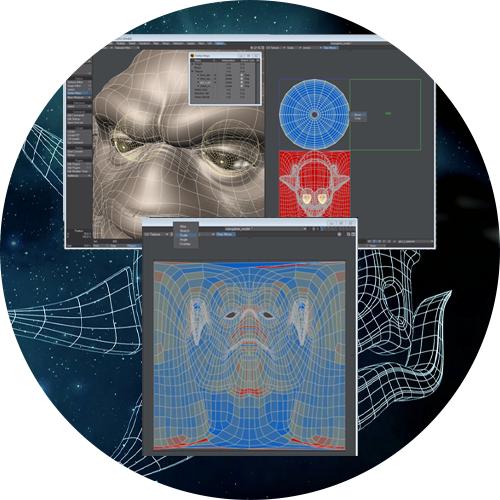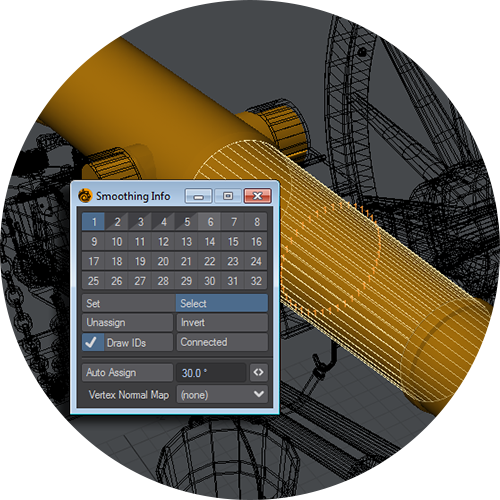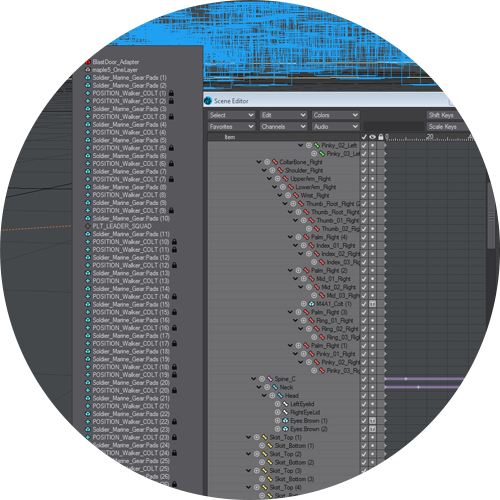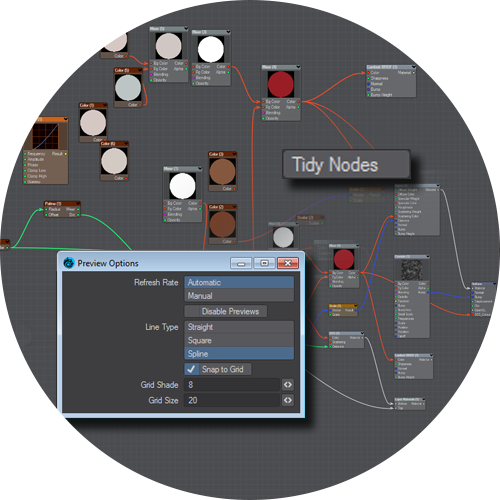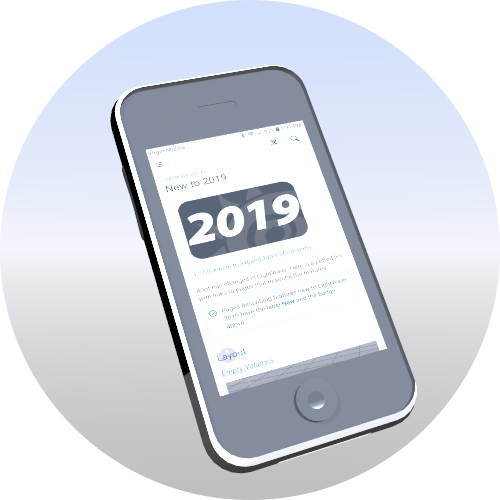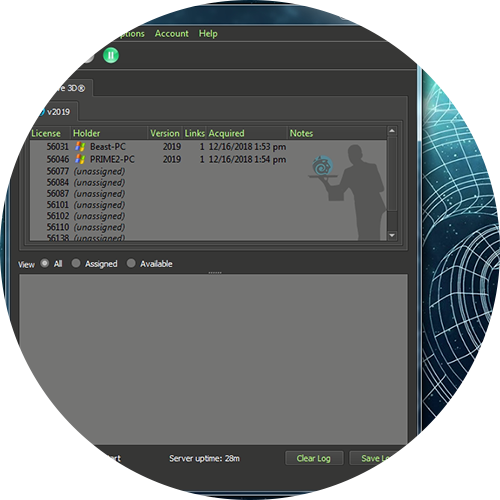LightWave, long known for the beauty of its render engine, gains new advancements in LightWave 2020 with the redesign of the Global Illumination rendering engine, bringing two versions for artists: Brute Force, an unbiased ra diosity engine, and Irradiance Cache, an interpolated radiosity engine. Using the new render engines independently or in concert will assure you get the real – world render results you seek, with higher quality and more control.
LightWave3D
LightWave 3D® 2020 provides Award-Winning, Production-Proven VFX and Animation Tools for Artists.
Check out all of the new features in LightWave3D 2020!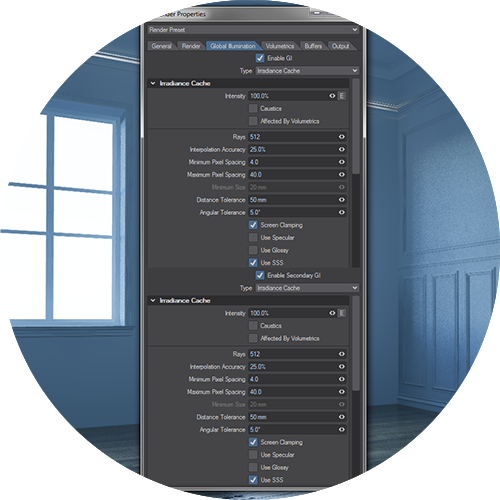
Two New Global Illumination Render Engines

LightWave 3D® 2020
Two New Shaders in FiberFX
The new hair shaders in LightWave 2020 deliver more realistic hair leveraging the physical based renderer. Principled Hair Material is based on the Principled BSDF settings. The five inputs: Color, Cutical Tilt, Roughness, Radial Roughne ss and Index of Refraction provide a simple interface for spectacular results. With AFC Hair Shader (Artist Friendly Control — a simplified approach) the specular settings are divided into two sections: Primary, for reflection of the front side of the stroke and Secondary for the reflection bounced off the backside of the stroke. Now, you have the option to select a simple artist friendly shading option or complete control for the look you desire.
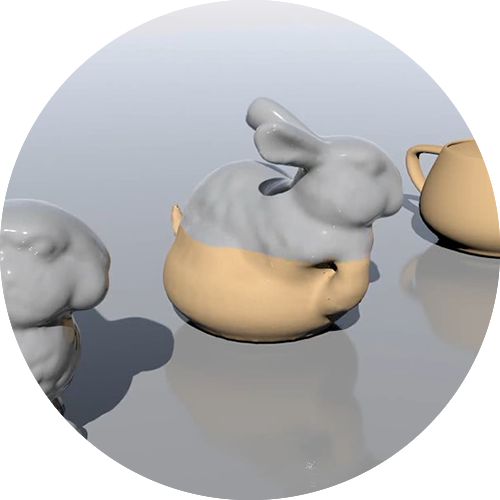
LightWave 3D® 2020
OpenVDB Gets New Set of Production Tools
Leading the pack in the LightWave OpenVDB roster is support for Partio particle objects. What you gain is the power of Houdini particles with the simplicity of the LightWave interface. Also included in the new OpenVDB toolset is:
- Advect Point Node – Advect particles by velocity grid
- Analysis Node – Grid creation Gradient, Curvature, Laplacian, Closest Point, Divergence, Curl, Magnitude, Normalize
- Combine Math Node – Combines grids using math operators
- Level Set Morph – Morph between level set grids
- Partio Node – Load Houdini.HClassic particle files
- VectorGrid Split and Merge – Split and merge Vector grids for further experimentation
- Visualize Node – Grid viewer with options
LightWave 3D® 2020
Redesigned Motion System
LightWave 2020 provides the ability to change Rotation Order per item and is saved with the scene file. This allows for an easier transition from other applications to LightWave. Additionally, instances of Gimbal lock can be avoided and items you are animating can be al lowed to follow a more natural rotation order.
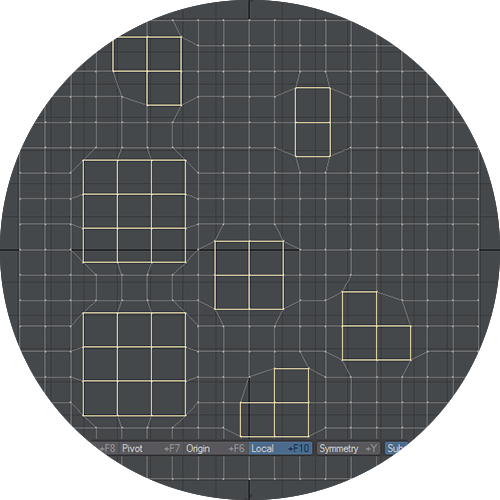
LightWave 3D® 2020
Local Action Center
LightWave Modeler allows you to impact a group of items all at once in the Local Action Center. Select disparate edges or polygons in your model and act on them as one, locally. The Local Action Center works on multiple layers at a time for fast and easy changes.
LightWave 3D® 2020
Tone Mappings
Gain greater control over the look of your render with the new Pixel Filter in LightWave 2020. Tone mapping is a tec hnique used in image processing and computer graphics to map one set of colors to another to approximate the appearance of high – dynamic – range images in a medium that has a more limited dynamic range. Further, as a Pixel Filter it can be used in VPR for qui ck results.
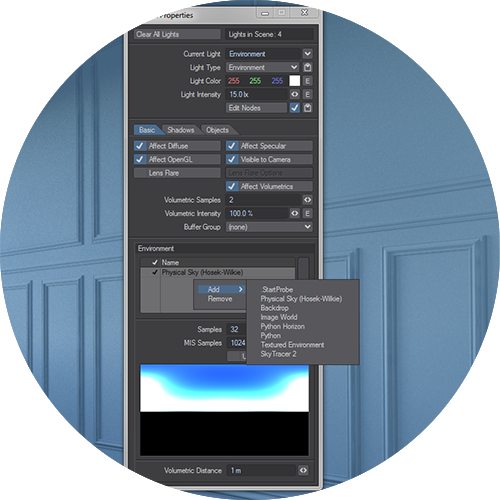
LightWave 3D® 2020
Shedding New Light
In LightWave 2020 the Environment Light has taken on new importance. Now, Environment Lights are connected directly to the environment, adding the direct sampling of the backdrop. The updated Environment Light opens as part of the default scene in Layout, and the new light results in the streamlining of environmental systems.
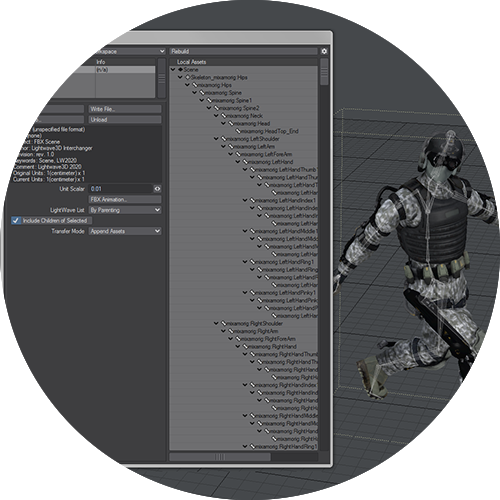
LightWave 3D® 2020
FBX Interchange
LightWave 2020 provides enhanced pipeline support, increasing access to motion capture for auto – rigging. More features are support in the FBX format, which provides greater flexibility when working with other animation tools.
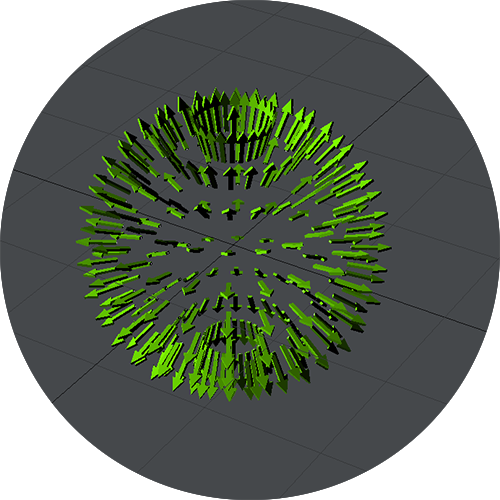
LightWave 3D® 2020
Instancing
Processing time for third party render engines is improved with the added ability to set Surface instances to static to stop evaluation at render time
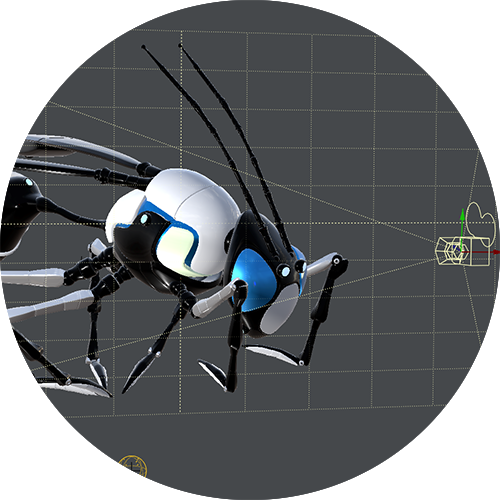
LightWave 3D® 2020
OpenGL
Updated shaders deliver visualization in the viewport that is closer than ever to the final render.
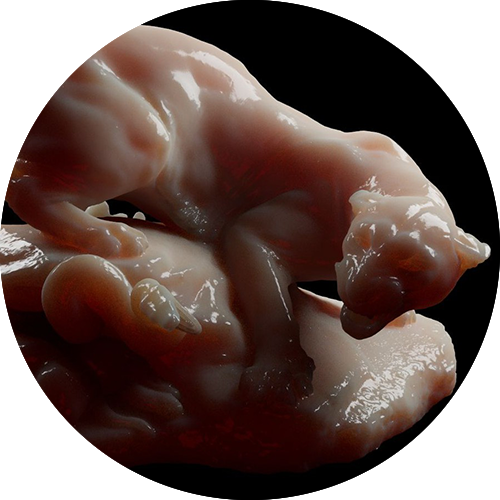
LightWave 3D® 2020
Improved SSS
Better subsurface scattering algorithm delivers fast, better SSS for your renders.
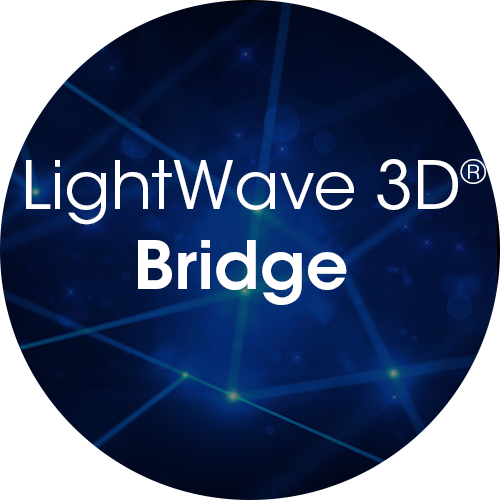
LightWave 3D® Bridge to Unreal Engine
Real-time Collaborative LightWave™ to Unreal Engine
LightWave 3D® enters the Real-Time Age for interchange with this workflow link between the Unreal Engine and LightWave 3D®, focusing on LightWave driving Unreal changes iteratively. Multiple LightWave seats are able to connect to the same Unreal Editor simultaneously to enable real-time collaboration between artists. The bridge uses NewTek’s proven NDI®network discovery mechanism for easy automatic configuration, and can be limited to single project use in Unreal, or installed as a general plugin for use in all Unreal projects.
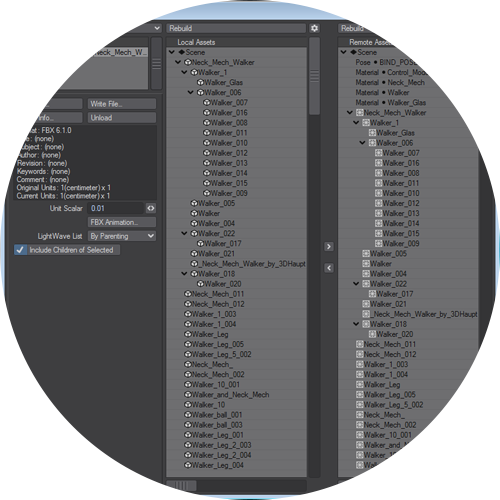
Improved FBX Interchange
FBX and New Interchange Bridge
Work with industry standard FBX data on a whole new level via the new Interchange Bridge.
- Interactively choose what to import / export and how.
- Add to existing FBX files from Layout and Modeler.
- Build LightWave 3D® assets from many FBX files.
- Easily revisit FBX files via workspaces.
- Support for:
- Vertex Caches
- Morph Mixer
- Vertex Maps
- Smoothing Groups
- Animation Layers
- Animation Baking
- Bones
- Hierarchies
- Meshes
- Pivots
- Mesh Freezing
Shading Model Customization Tools
Shading Model Customization Tools
The ability to pull materials apart and build them to your tastes is new to LightWave 3D® 2019. There is access to Fresnel Functions, Material Components and Material Integrators. The Material Tools Group has been updated with new nodes to support this capability.
OpenVDB Creation
OpenVDB Content Creation
LightWave 3D® 2018 introduced the ability to import and render an OpenVDB fog volume. New for LightWave 3D® 2019 is a set of node tools that allow OpenVDB content creation. You can now create OpenVDB grids from meshes, particles, and even the shape primitive distance estimator. The tool kit allows for live Constructive Solid Geometry (CSG) operations, grid filtering including level set tracking, smoothing, dilation and erosion. Solvers are included that allow for fluid simulation and smoke and fire effects.
Metamorphic Animated Sculpting/Painting
Metamorphic
Metamorphic is a multipurpose animatable mesh sculpting and vertex map manipulation plug-in for LightWave 3D® 2019 that works in Layout, and takes full advantage of the new capabilities of the modifier stack.
- Freeform animated sculpting
- Built-in undo/redo system
- Fully-multithreaded sculpting using all available CPU cores
- Pen pressure support for brush size, strength and hardness (Windows only)
- Nodal brush texture support
- Three modes of animation
- Non-linear interpolation of sculpt animation keyframes
- Supports converting sculpt animation key frames to Endomorphs
- Predictive corrective morph sculpting that works after deformers with built-in driver/driven controller
- Full Motion Blur support
Display Scaling
Display Scaling
- Support for scaling many UI elements for HiDPI and large-screen displays
- Independent scaling options for multi-monitor setups
Bone Enhancements for Game Development
Bone System Improved for Game Development
The new Bone Type option, Limited Bones, allows the animator to set a limit in Layout on the number of bones that affect a given point to match the limit in the target game engine, and engages real-time optimizations to more closely match the performance game engines expect from a rig.
Shading and Rendering Enhancements
Shading and Rendering Enhancements
Procedural Shader Node
This node encapsulates a chosen legacy system LightWave 3D® or third party procedural texture and exposes it with the typical nodal inputs and outputs. Previously, such procedurals were only available inside a Procedural texture layer of a texture stack.
Shading and Rendering Enhancements
New Compositing Buffers
The new Rho buffer is for extracting lighting and shading information from the direct and indirect buffers. A new Weight buffer contains the value of the surface shader settings for both direct and indirect buffers. These are useful for heavy compositing work.
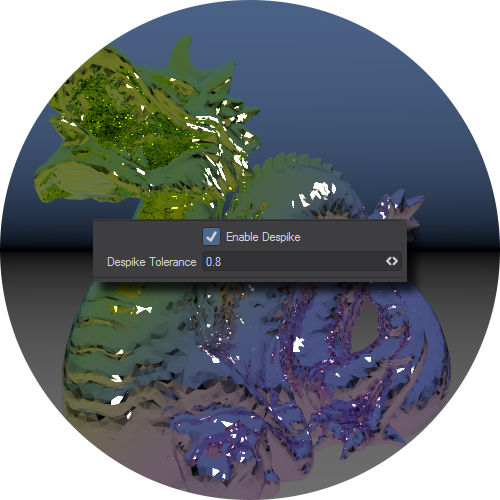
Shading and Rendering Enhancements
Despike
This new Renderer option is a tool for reducing or removing “fireflies” in renders.
Physical Sky and SunLight
Game Development Enhancements in Modeler
Game Development Enhancements in Modeler
Enhanced UV and UDIM Mapping Workflow
Modeler has added a suite of new tools for working with UV maps as well as UDIM tiled mapping:
- FlipUV-U
- FlipUV-V
- MoveUDIM
- Turn Poly UV
- SelectUV Island
- SelectUV overlap
- SpreadUV
- Rectangular UV Grid
- New view modes for working with UVs:
- Sketch
- Scale
- Angle
- Overlap
Game Development Enhancements in Modeler
Smoothing Groups
Modeler now supports the creation of smoothing groups within a mesh. Smoothing groups provide a way to create creases and hard edges, and more precisely control regional contours on your model. You are no longer limited to a single smoothing angle, adding extra control geometry, or breaking your model into parts to achieve the look you desire. Smoothing groups can be created automatically using a vertex normal map, imported with OBJ files, by using a smoothing angle threshold or manually. Smoothing groups can be exchanged with other software that supports the format.
New Primitive and Tools
New Primitive & Tools
Empty Volume Shape Primitive
LightWave 3D® 2019 adds the new Shape Primitive, Empty Volume, which can be used for creating procedural surface shapes. In addition to being directly useful in scenes, the Empty Volume primitive is helpful in workflows that need to convert meshes to volumes or vice versa. Empty Volume can also provide for real-time Boolean operations in Layout.
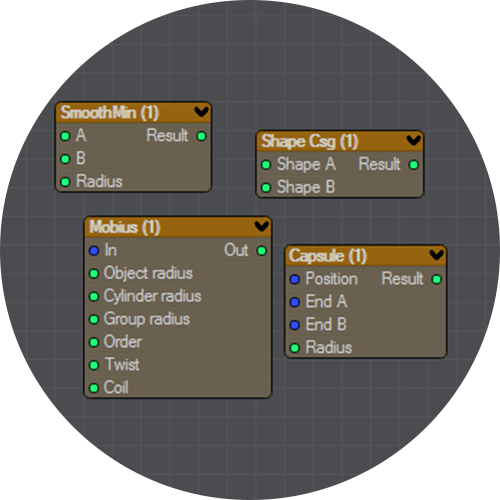
New Primitive & Tools
New Tools for Shape Primitives
The Empty Volume shape primitive allows advanced users to write their own distance estimators for rendered SDF shapes and volumetrics.
Other new nodal distance tools include:- Mobius
- Capsule
- Shape CSG (Constructive Solid Geometry)
- SmoothMin, a soft blending node.
Workflow and UI
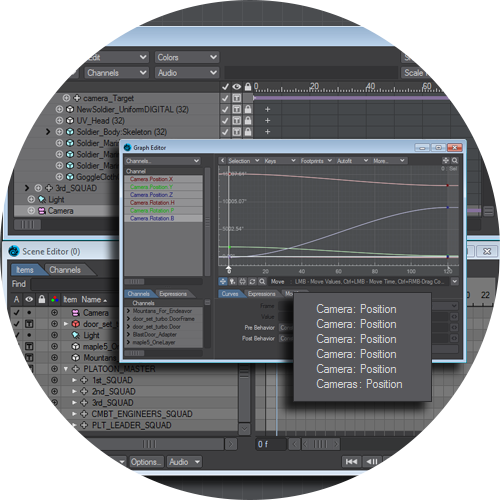
Workflow and UI
Expanded Layout Undo System
The Layout Undo System has been expanded to many of the systems involving Transforms & Keys. Unlimited Undo is now available in:
- Graph Editor
- Scene Editors, both new and classic
- Dope Sheet
- Many Layout navigation tools
Workflow and UI
Node Graph UI Options
- Tidy Nodes Command: A tool to make ‘cluttered’ node trees ‘straight’ and easier to read from left to right automatically.
- Background Grid: You can adjust the brightness and color of the grid in the Node Editor
- Snap to Grid: you can turn on this tool to make the nodes ‘snap’ to a user settable grid size.
LightWave3D 2020 Full Seats and Upgrades

LightWave3D 2020 Educational Seats and Upgrades

Check out the powerful features of LightWave3D
Modeling
LightWave set the standard for polygonal, subdivision surface modeling a decade before many of the other 3D software packages included even basic polygonal modeling tools. While others were basing their pipelines on clunky spline-patching workflows, LightWave artists were quickly and efficiently modeling with smooth subdivision surfaces interactively. LightWave continues to offer powerful, rock-solid modeling tools and the latest versions of LightWave raise the bar with increased interactivity and ease of use.Surfacing
LightWave offers two surfacing systems to the artist. A fast, simple to use layer-based system, and a very flexible and powerful nodal system. Each offer different workflows to suit the artist – for quick results, the layered system is perfect for fast visualization and concept design. For those who like to dig deep, the nodal system offers ultimate creative freedom. These systems can be used independently of each other, but unique to LightWave is the ability to mix them together. You can use the layered surfacing to achieve results quickly, then choose any of the surface properties to use in a nodal context. This allows you to create extremely complex results very quickly. The node system also includes easy to use physically accurate material shaders for glass, metal, skin and carpaint, allowing you to achieve photoreal results quickly.Rigging
The rigging tools in LightWave are fast and flexible and again offer artists choices in workflow. LightWave pioneered a very powerful and easy to set up automatic joint influence falloff system. This means that you can either choose to setup industry standard weight maps for your characters and rigged geometry or you can elect to bypass that often time-consuming weight mapping process for quick visualization and concept design animation workflows by using the automatic joint falloff that is built in to LightWave’s animation system. This allows you to quickly and easily swap out geometry in rigs with zero weight map hassles. But you always have the choice to work with weight maps for that added control when your project requires it.Animation
LightWave includes powerful procedural, nodal, and keyframe animation tools. An easy to use and customizable keyframe graph editor allows you to quickly place and edit keys, time scale, filter, and even manipulate your animations with expressions. Bake your animations per keyframe or with frame stepping and create motion clips to blend together within the non-linear motion mixer. You can even bake animations to Autodesk geometry cache or industry standard MDD files to simplify the scene for rendering or for export to other animation packages. For facial animation LightWave includes an efficient blend-shape system called Endomorphs which includes all of your morph targets within your base object. Endomorphs can even be sculpted in ZBrush using the new ZBrush GoZ interchange tools included in LightWave.Virtual Studio Tools
LightWave’s development team is bridging the gap between real and virtual worlds, by bringing together the broadest array in any application of new devices with which to interact with the set and characters inside LightWave’s virtual stage and model shop. Device support ranges from economical mice, tablets and game system controllers to the sensor arrays and custom cameras and devices used let directors, lighting grips and camera operators walk a real set and fully capture their data into the virtual set modeled in LightWave. Applications range from propelling your camera on an architectural flythrough using a 6DoF mouse to puppeteering your characters live on stage using Playstation Move controllers, to recording every camera move shot for shot for a major motion picture, a technique pioneered on the film Avatar.Instancing
Instancing allows vast duplication of objects in a scene with very little overhead. With instancing huge ‘virtual’ polygon counts can be achieved allowing the artist to populate their scenes with incredible detail, yet retain reasonable render times and memory usage. While instances can be thought of as clones of the original source objects, they do not need to look identical. They can be randomly scaled, positioned, rotated and even surfaced entirely differently from the source, allowing for a huge variety of uses.Effects
Bullet Dynamics
Bullet is a fast, production-proven, open source physics engine that is used in many high profile, effects-driven films and real-time game engines. Bullet features 3D rigid body dynamics originally created by Erwin Coumans. LightWave 11 features the Bullet dynamics engine directly in Layout so that it can be used with the new Fracture tool in Modeler to create compelling physics-based animation. Things like collapsing buildings, explosions, and even natural placement of items in a random pattern, would otherwise be difficult to do by hand.HyperVoxels
Hypervoxels allows you to create beautiful smoke, flame, liquids, explosions, nebulas, clouds or any other volumetric effect that you can imagine. With real-time interactive support within LightWave’s VPR, you can experiment and adjust volumetric effects to your heart’s content. All calculated at beautiful, final render quality directly within the LightWave interface.ParticleFX
Is a robust, fully-featured particle engine within LightWave. The flexibility of ParticleFX allows a wide variety of looks; from explosive effects to slow moving smoke-like behaviors. Particle emitters can be stand-alone, or attached to objects to emit particles from their vertices, polygon normals or surfaces. ParticleFX works seamlessly with HyperVoxels to allow the rendering of particles in any way imaginable.FiberFX
If you need hair, fur, feathers, or scales then the FiberFX tools included with LightWave are just what you are looking for. Styling and guide creation tools are included so that you can get your fibers looking just as you envision. FiberFX is known for its visual quality and its consistent look in various different lighting environments. FiberFX includes a beautiful and speedy pixel shader mode and for complex scenes where you need fibers to be ray traced in reflections or refractions you have the option of a more detailed volumetric mode.Flocking
LightWave’s flocking system is based on 3D computer models of coordinated animal motion, things like flocks of birds, herds of animals or schools of fish. It can be used with LightWave’s instancing system or HyperVoxels. Use the Flock controller, which calculates crowd avoidance of neighbors, target alignment, and cohesive attractions, to create realistic natural motions, with ease. Classic examples of flocking motion are:- Flocks of Birds
- Schools of Fish
- Swarms of Insects
- Animal Herd Behaviors
- Craft Maneuvers (planes, alien ships, etc)

